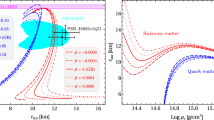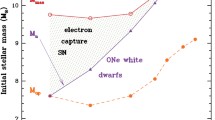Abstract
The further evolution of a massive X-ray binary consisting of a compact object and an OB supergiant is outlined. The supergiant exceeds its critical Roche lobe and a second stage of mass transfer starts. The remnant of the mass losing star — a pure helium star — develops a collapsing iron core and finally undergoes a supernova explosion. If the compact companion is a black hole the system remains bound; if the compact companion is a neutron star the system is disrupted unless an extra kick allowing an asymmetric explosion is given. Computations were performed for the massive binary 22.5M ⊙+2M ⊙. The possible final evolutionary products are: (1) a black hole and a compact object, in a binary system, (2) two run-away pulsars, (3) a binary pulsar.
As final parameters for the described system the eccentricity and period for the recently discovered binary pulsar 1913+16 may be found. An orbital inclination ofi=40° may be derived. The probability for the generation of binary pulsars is very low; in most cases the system is disrupted during the supernova explosion.
Similar content being viewed by others
References
Arnett, W. D.: 1973, in D. N. Schramm and W. D. Arnett (eds.),Explosive Nucleosynthesis, Univ. of Texas Press, Austin, p. 236.
Boersma, J.: 1961,Bull. Astron. Inst. Neth. 15, 291.
de Loore, C., de Grève, J. P., Van den Heuvel, E. P. J., and de Cuyper, J. P.: 1974,Proceedings of the 2nd IAU Regional Meeting at Trieste, in press.
de Loore, C. and de Grève, J. P.: 1975,Astrophys. Space Sci. 35, 241.
Gunn, J. E. and Ostriker, J. P.: 1970,Astrophys. J. 160, 979.
Hensberge, G., Van den Heuvel, E. P. J., and Paes de Barros, M. H.:Astron. Astrophys. 29, 69.
Paczyński, B.: 1971.,Acta Astronomica 21, 1.
Ruderman, M.: 1972,Ann. Rev. Astron. Astrophys. 10, 427.
Sparks, W. M. and Stecher, T. P.: 1974,Astrophys. J. 188, 149.
Taylor, J. H. and Hulse, R. A.: 1974,IAU Circ. No. 2704, October 4.
Van den Heuvel, E. P. J.: 1973,Nature Phys. Sci. 242, 118.
Van den Heuvel, E. P. J. and de Loore, C.: 1973,Astron. Astrophys. 25, 387.
Van den Heuvel, E. P. J. and de Loore, C.: 1975,Astron. Astrophys., in press.
Van den Heuvel, E. P. J. and Heise, J.: 1972,Nature 239, 67.
Van den Heuvel, E. P. J. and Ostriker, J. P.: 1973,Nature Phys. Sci. 245, 146.
Zel'dovich, Y. B., Ivanova, L. N., and Nadezhdin, D. K.: 1972,Soviet Astron. 16, 209.
Zytkov, A. and Thorne, K. S.: 1974,Workshop on Compact X-Ray Sources, Grignano, Trieste.
Author information
Authors and Affiliations
Rights and permissions
About this article
Cite this article
de Loore, C., de Grève, J.P. & de Cuyper, J.P. Evolution of massive close binaries. Astrophys Space Sci 36, 219–225 (1975). https://doi.org/10.1007/BF00681952
Received:
Issue Date:
DOI: https://doi.org/10.1007/BF00681952




